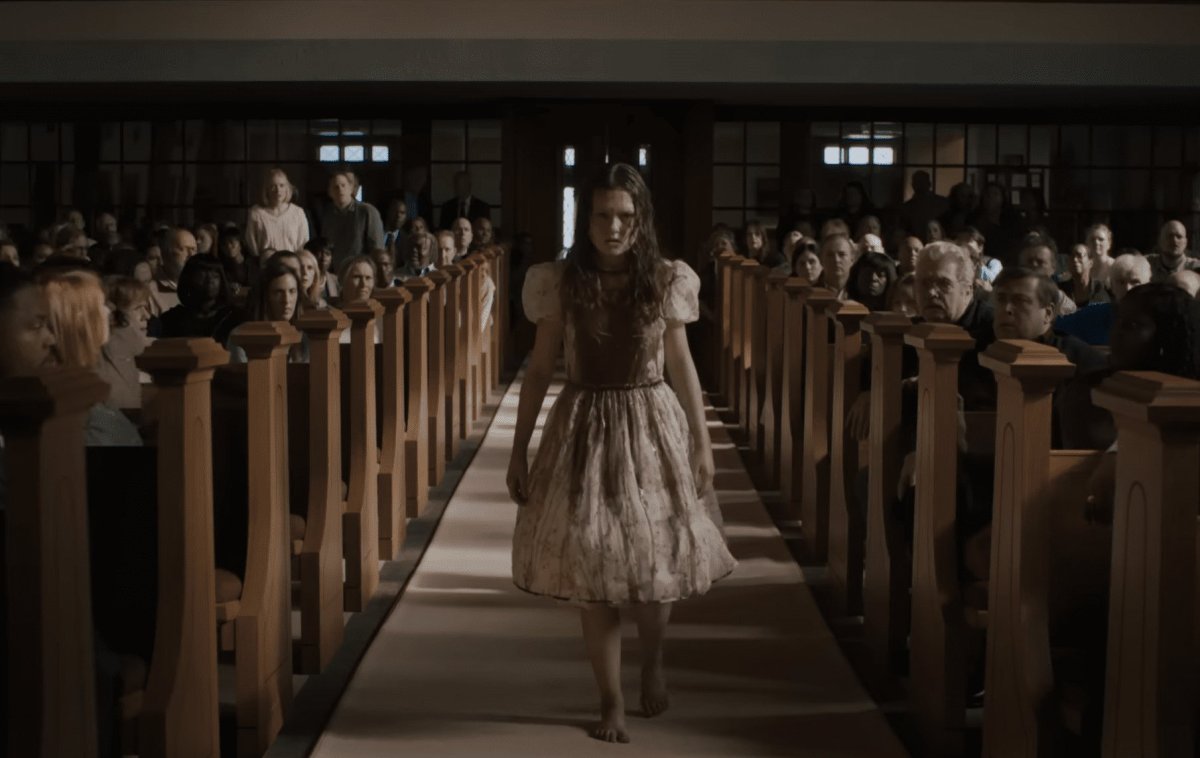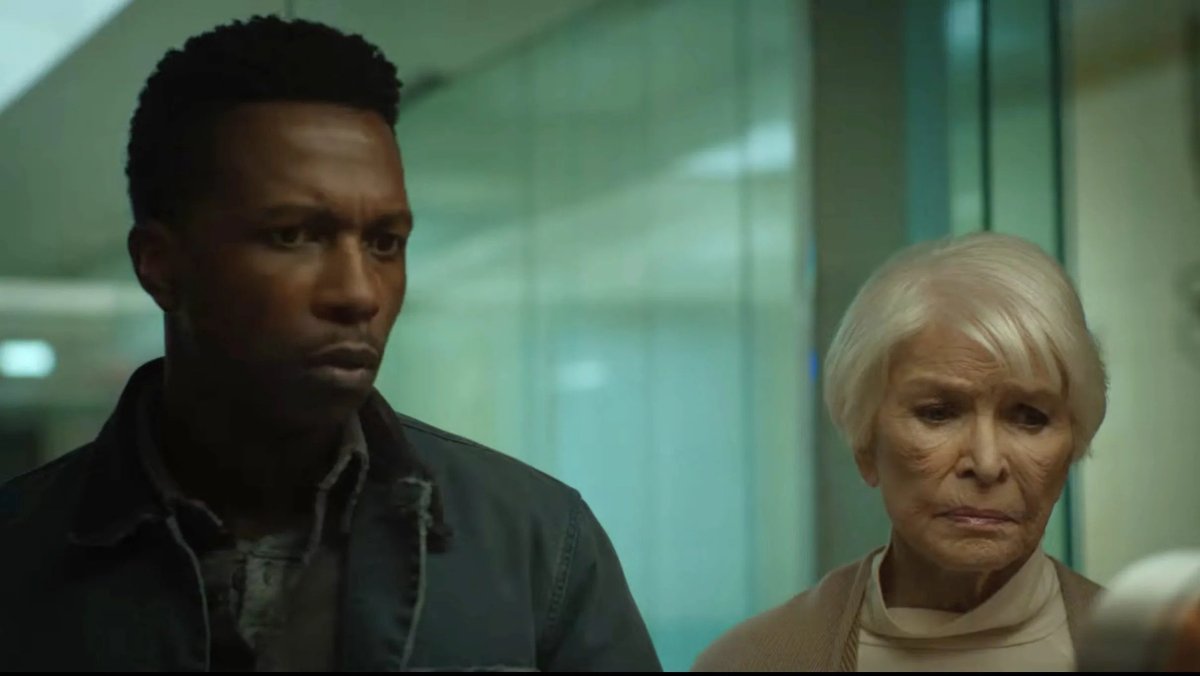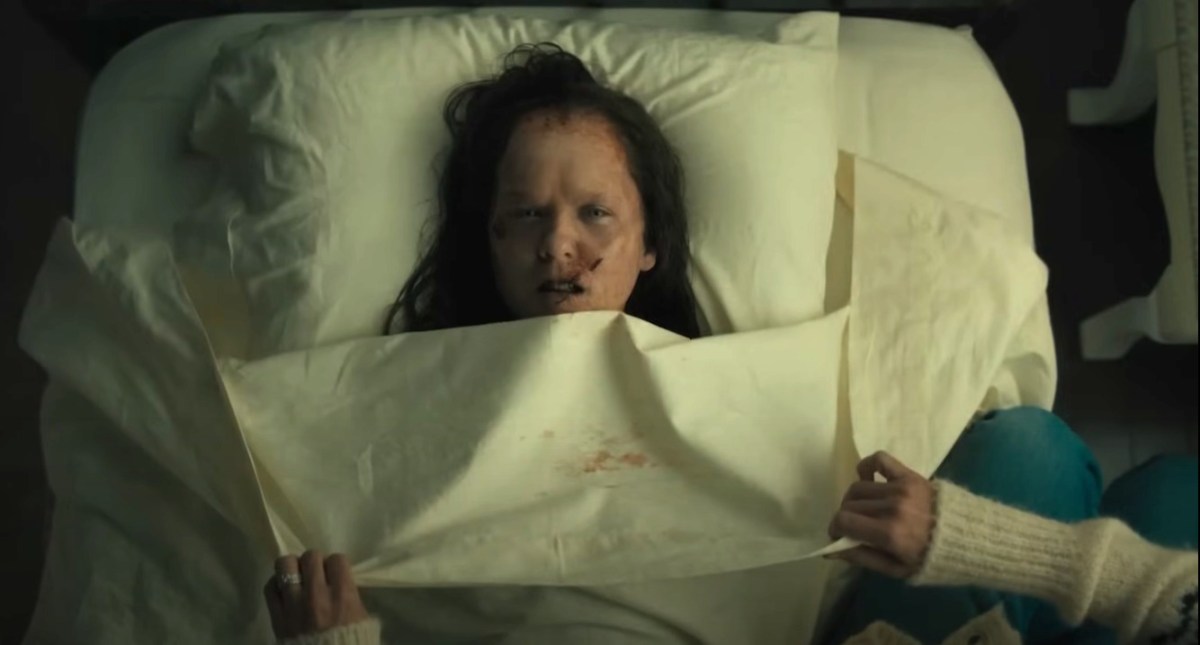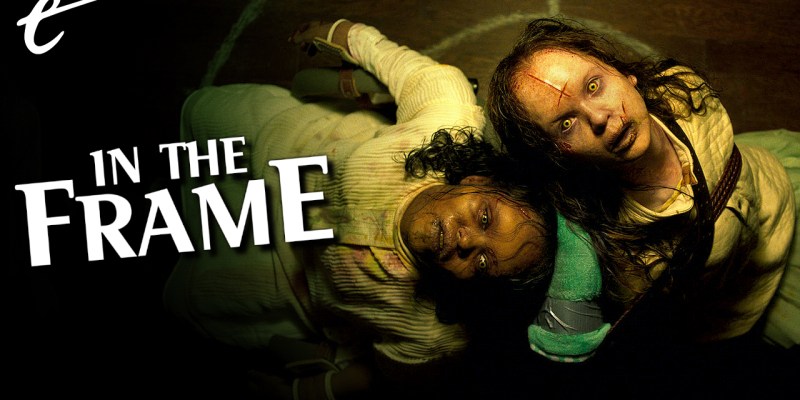This discussion and review of The Exorcist: Believer contains some spoilers.
The Exorcist: Believer begins with two dogs wrestling. Like a lot of the movie, this is a direct reference to William Friedkin’s The Exorcist, evoking a brief shot from the extended prologue that follows Father Lankester Merrin (Max von Sydow) during an excavation in Northern Iraq. However, while that shot comes early in The Exorcist, it is not the opening shot. As such, its position in Believer is more than just an affectionate and nostalgic homage. It is a statement of purpose.
Throughout Believer, there is a recurring emphasis on doubling and division. Just as the original movie opened overseas in Northern Iraq, Believer features a prologue in Port-au-Prince, Haiti. Photographer Victor Fielding (Leslie Odom Jr.) and his pregnant wife Sorenne (Tracey Graves) find themselves caught in the midst of the devastating 2010 Haiti earthquake. Sorenne is injured, and Victor finds himself forced to choose between saving his wife or their unborn child.
The bulk of the film’s plot unfolds thirteen years after this introductory sequence. Victor is living with his teenage daughter Angela (Lidya Jewett). Just as in the original Exorcist, a single-parent family finds itself besieged by demonic forces. However, the central conceit of Believer is something of a franchise escalation. This is not the story of a single case of demonic possession. Instead, it is the story of two young girls – and two families – caught in an unimaginable horror.
One afternoon, Angela goes off into the woods with her friend, Katherine (Olivia Marcum). The two girls try a conjuring ritual to communicate with Sorenne’s spirit. Inevitably, they open the door for something monstrous to sneak through. They disappear. Three days later, the two girls are found in a stable. In the days that follow, Angela and Katherine subject their families to a variety of terrors. As the title of the movie promises, this builds to an extended climactic exorcism sequence.
Even before anything explicitly supernatural happens, there is an anger permeating Believer. Most of the cast live in the same community, as neighbors or schoolmates. However, they are introduced antagonistically. Victor’s neighbor Ann (Ann Dowd) is first seen complaining about the fact that Victor and Angela haven’t brought in their bins off the road. Katherine’s father Tony (Norbert Leo Butz) announces his presence by angrily honking his horn at Victor outside their daughters’ school.

When Katherine and Angela go missing, Victor quickly finds himself at odds with Tony and Katherine’s mother Miranda (Jennifer Nettles). The two families seem to blame each other for the disappearance. When they post missing person fliers, each family posts for their own child. When Tony makes a statement to the press stating his hope that Katherine will be returned, his local minister, Don Revans (Raphael Sbarge), has to stress that the congregation are praying for both girls.
In this context, it feels pointed that Katherine is white and Angela is Black. As has been thoroughly documented, there is a double standard in how such cases are treated, with missing white children receiving disproportionate attention compared to children of color. Indeed, even after the children are returned, they initially seem to live separate and isolated lives. Director David Gordon Green offers some very effective shots of the pair staring at one another through the windows of hospital examination rooms.
As much as this dual possession plays as a self-aware riff on the tendency of sequels to go bigger – what is bigger than an exorcism? Two exorcisms! – it serves a clear thematic purpose. This becomes obvious as the movie enters its climax. As the characters assemble to perform the exorcism, the demon inside the girls taunts them. “One girl lives, one girl dies,” it teases. “You get to choose.” It’s a very deliberate echo of the choice that Victor made earlier in the movie, between his wife and child.
It also ties back into the movie’s central theme of division. Once again, Victor is thrown into conflict with Tony and Miranda. The demon is trying to divide them, to set them against one another. It is trying to sow conflict by suggesting that this is a competition and that there can only be one winner. It tries to turn them into the dogs from that opening scene, wrestling among themselves as evil takes root. As with so many effective horror movie premises, it’s an effective piece of social commentary.
The obvious point of comparison for Believer is the recent Halloween trilogy, another Blumhouse production. Like that Halloween trilogy, Believer seems to wipe all previous Exorcist sequels from continuity. Just as that Halloween trilogy brought back Jamie Lee Curtis to reprise the iconic role of Laurie Strode, Believer makes a big deal of being the first Exorcist sequel to convince Ellen Burstyn to reprise her Oscar-nominated role from the original film. Believer is even intended to launch a trilogy.
 However, the connection runs deeper than that. Believer is directed and co-written by David Gordon Green, who was also the architect of that recent Halloween trilogy. Green’s frequent collaborator, and co-writer of that recent Halloween trilogy, Danny McBride has a story credit on the film. Even beyond the fact that these are both attempts to revive iconic 1970s horror franchises by going back to the root, there’s a surprising thematic overlap between the two.
However, the connection runs deeper than that. Believer is directed and co-written by David Gordon Green, who was also the architect of that recent Halloween trilogy. Green’s frequent collaborator, and co-writer of that recent Halloween trilogy, Danny McBride has a story credit on the film. Even beyond the fact that these are both attempts to revive iconic 1970s horror franchises by going back to the root, there’s a surprising thematic overlap between the two.
Green’s Halloween trilogy, particularly Halloween Kills and Halloween Ends, are fundamentally about how the small town of Haddenfield has been broken by the horrors inflicted by Michael Myers (Nick Castle). At their core, these films are about the decay of the social fabric. With only the slightest provocation, this seemingly idyllic community turns on itself and devolves into complete chaos. Myers is really just a catalyst that accelerates a more fundamental erosion of norms.
Halloween Kills has been read as a metaphor for Donald Trump’s America and retroactively framed in terms of the January 6th riots. As Curtis explained, Halloween Kills is about “community trauma, community rage and rage against the machine.” Even Halloween Ends is about how the community ostracizes Corey Cunningham (Rohan Campbell) in the wake of a horrific tragedy. It is about a young man who is transformed into the boogeyman because his community can’t process its trauma.
Although Halloween Kills was shot before the global pandemic deepened these social divisions, these themes are certainly timely. The United States is highly polarized, even by the standards of a very polarized time. It can often feel like Americans no longer even share a common reality. These divisions cut across every facet of American life: politics, race relations, economics. Americans are living in what psychology professor Raymond Novaco describes as “a big anger incubator.”
Believer taps into this. In this sense, it is a film that is very much in conversation with the language and conventions of classic exorcism movies, most obviously codified by The Exorcist. As a rule, these movies are inherently conservative and they tend towards an often very narrow Christian perspective. They are fundamentally stories about how America has abandoned a particular religious outlook, and how the only way to confront true evil is through a return to those specific values.

In contrast, Believer is about how evil can only truly be vanquished by unity and cooperation. The exorcism ritual at the climax of the movie involves multiple faiths coming together. Ann represents Catholicism and Don represents Protestantism. They are joined by Dr. Beehibe (Okwui Okpokwasili), who practices “rootwork,” a spiritual tradition practiced by many of the slaves brought to America. Only together can they hope to cast out the demon.
When the Catholic Church refuses to officially sanction an exorcism due to the risk involved, Father Maddox (E.J. Bonilla) sits outside in his car and prays for the two girls. Victor taps on the window. “Fight’s inside, padre,” he urges the priest. Maddox is convinced to join in the ritual, even though it ultimately costs him his life. Despite their initial antagonism and skepticism, the characters are able to stand up to the demonic entity by presenting a united front.
After all, the demon offers its own twisted sense of unity. As the assembled characters prepare for the ritual, Ann hooks Angela and Katherine up to a set of heartbeat monitors. Miranda notices the steady rhythms coming from the machines. “They’re in sync,” Ann explains. As much as the demon insists that the families must choose one child over another, the truth is that Angela and Katherine are ultimately the same. As Victor promises his daughter, “If you don’t make it, I don’t make it.”
Indeed, Believer argues that division is self-defeating. It is eventually revealed that Victor actually chose to save his wife Sorenne after the earthquake in Haiti, it just didn’t work out the way that he planned. Sorenne didn’t make it, but Angela did. At the movie’s climax, in a moment of weakness, Tony breaks and tries to bargain with the demon. “I choose Katherine!” he screams, to the horror of everybody in the room. Katherine doesn’t make it, but Angela does. In a way, Tony does choose.
In its own way, Believer is a timely piece of horror cinema, a dark allegory about the way in which the modern world seems designed to pit people against one another and force them to make monstrous choices that fundamentally compromise them. It’s a movie about the divisions at the heart of these sorts of communities, and how evil festers in those spaces. Like David Gordon Green’s Halloween, Believer uses an existing horror franchise to construct a parable for modern America.
